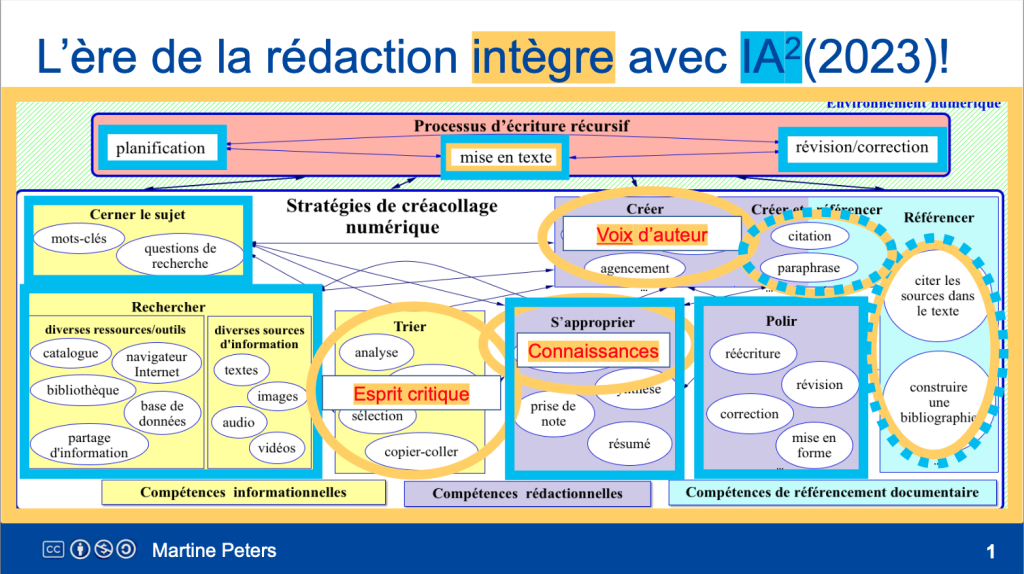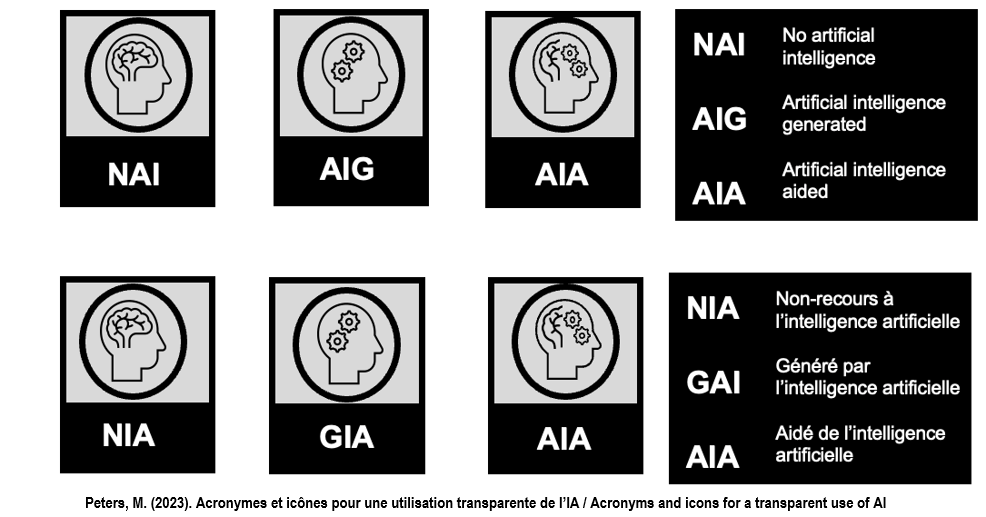Regard critique sur l’évaluation :
Conjuguer avec l’intelligence artificielle et l’intégrité académique IA1 et IA2
Par Martine Peters, Université du Québec en Outaouais
Séminaire de Sherbrooke
(9 janvier 2024)
Références
Diapositive 7 : Définition du plagiat
- (2023). Is ChatGPT Plagiarism? No. Here’s Why We Think So. Nerd Chalk https://nerdschalk.com/is-chatgpt-plagiarism
Diapositive 11 : Icônes pour être transparent
- Peters, M. (2023). Acronymes et icônes pour un usage transparent de l’IA / Acronyms and icons for a transparent use of AI. http://w4.uqo.ca/mpeters/ateliers-workshops/
Diapositives 12 : Modèles de rédaction de stratégies de créacollage numérique
- Peters, M. (2023). L’ère de la rédaction intègre avec l’intelligence artificielle, modèle 2023 : http://w4.uqo.ca/mpeters/ateliers-workshops/
Diapositives 16-17 : Template Classroom AI Use
- Miller, M. (2023). Template Classroom AI Use: What’s Cheating? What’s OK? https://ditchthattextbook.com/ai-cheating/
Diapositive 18 : C’est le temps de repenser les notions de « Plagiat » et de « Triche »
- Duguay, S. (2023). C’est le temps de repenser les notions de « Plagiat » et de « Triche ». Traduction de l’original « It’s Time to Rethink “Plagiarism” and “Cheating” de Matt Miller (DitchThatTextbook.com) https://ditchthattextbook.com/ai/#tve-jump-18606008967
- Collaboration spéciale (2023). L’IA à l’école : qu’est-ce qui est de la triche, qu’est-ce qui est correct? École Branchée. https://ecolebranchee.com/ia-en-classe-qu-est-ce-qui-est-de-la-triche-qu-est-ce-qui-est-correct/?mc_cid=b80d5f0984&mc_eid=012c4053c0
Diapositive 19 : Permis oui ou non?
- Hough, D. (2023). Student Guidance for the Responsible Use of AI. University of Glasgow. Edited by Rachel Heyes. #ALTc blog, October 10. https://altc.alt.ac.uk/blog/2023/10/student-guidance-for-the-responsible-use-of-ai/#gref
Diapositive 20 : Pour les étudiants / élèves
- Long, L. (2023). Acknowledging and Citing Generative AI in Academic Work. Idaho Open Press, Write What Matters. https://idaho.pressbooks.pub/write/chapter/citing-generative-ai-in-academic-work/?fbclid=IwAR1tgfgk0B1RPzlnHeLck3UgWX-VaHGlzf3LPNjLgqF7zggilvN5rSJhOU0
Diapositive 22 : Période de deuil
- Crisci, J. (2023). An important note for anyone doing AI PD for teachers. [LinkedIn]. https://www.linkedin.com/posts/jerrycrisci_an-important-note-for-anyone-doing-ai-pd-activity-7128070990684717056-V47e?utm_source=share&utm_medium=member_desktop
Diapositive 23 : Redéfinir l’évaluation
- Lodge, Howard and Broadbent (2023). Assessment redesigne for generative AI: A taxonomy of options and their viability. LinkedIn. https://www.linkedin.com/pulse/assessment-redesign-generative-ai-taxonomy-options-viability-lodge/?fbclid=IwAR2IGAAocNIMWoj9AIyBWQLiEIaJP12-9UQCaLQrH7wGp6ugTcfvUGCuE7Y
Diapositive 25 : Classe inversée
- Roy, N. (2014). La classe inversée : une pédagogie renversante? Le Tableau, 2014, Volume 3, No. 1. Direction du soutien à l’enseignement et des bibliothèques (DSEB) en collaboration avec le Groupe d’intervention et d’innovation pédagogique (GRIIP). https://pedagogie.uquebec.ca/le-tableau/la-classe-inversee-une-pedagogie-renversante
- Version PDF en ligne : https://pedagogie.uquebec.ca/sites/default/files/documents/numeros-tableau/letableau-v3-n1_2014b_1.pdf
Diapositive 26 : Apprentissage transformateur (Jack Mezirow)
- Western Governors University. (2020). What is the Transformative Learning Today? [Blog]. Teaching & Education. https://www.wgu.edu/blog/what-transformative-learning-theory2007.html#close
- Moreira, C. (2011). L’apprentissage transformateur selon Jack Mezirow. Fiches pédagogiques. Le Centre d’Information et d’Éducation Populaire (CIEP) communautaire. https://www.ciep.be/images/BoiteAOutils/FichePedagEspeluette/F.PedEsper93.pdf
Diapositive 27 : Le débat ❤️
- Bauschard, S. (2023, November 05). Debating in the World of AI. Stefan Bauschard. Education Disrupted: Teaching and Learning in An AI World. https://stefanbauschard.substack.com/p/debating-in-the-world-of-ai?utm_source=post-email-title&publication_id=1673728&post_id=138620336&utm_campaign=email-post-title&isFreemail=true&r=2fm3lf&utm_medium=email
Diapositive 28 : L’évaluation authentique ❤️
- Furze, L. (2023, October 04). Rethinking Assessment for Generative AI: Beyon the Essay. LeonFurze.com. https://leonfurze.com/2023/10/04/rethinking-assessment-for-generative-ai-beyond-the-essay/?fbclid=IwAR2AovmNzhN94MJlxPSkffge-Hh58PALY-q2wcedRu5uJZnSLO20JPytGTQ
Diapositive 29 : Caractéristique d’une activité d’évaluation authentique intègre
- Modèle d’évaluation proposée, Peters, Smith et Angelov. (2023). http://w4.uqo.ca/mpeters/ateliers-workshops
Diapositive 30 : Tâches impossibles pour les IA2 (en ce moment 11-2023)
- Mialon, G., Fourrier, C., Swift, C., Wolf, T., LeCun, Y. & Scialom, T. (2023). GAIA: a Benchmark for General AI Assistants. https://arxiv.org/pdf/2311.12983.pdf
Diapositive 32 : Modèle d’évaluation proposée
- Peters, M., Smith, J. et Angelov, D. (2023). Planification d’une tâche évaluative qui favorise la créativité et l’intégrité académique. http://w4.uqo.ca/mpeters/ateliers-workshops
Diapositives 34-36 : Taxonomie de Bloom révisée / Objectifs et IA2
- Anderson, L.W., Krathwohl, D.R., Airasian, P.W., Cruikshank, K.A., Mayer, R.E., Pintrich, P.R., Raths, J., & Wittrock, M.C. (2001). A taxonomy for learning, teaching, and assessing: A revision of Bloom’s Taxonomy of Educational Objectives (Complete edition). New York: Longman.
- Prof Innovant. (2023). Taxonomie de Bloom révisée : verbes d’action. https://www.profinnovant.com/taxonomie-de-bloom-revisee-verbes-daction/
- Oregon State University. (2023). Advancing Meaningful Learning in the Age of AI: Bloom’s Taxonomy Revisited. https://ecampus.oregonstate.edu/faculty/artificial-intelligence-tools/meaningful-learning/?fbclid=IwAR3nzsEV0-BTPXTRdgAW6EqcbyL3pWx-LmNfH88fVjew-hZLEMe3-z5Wn1Y
- Stasse, S. (2023). Bloom revisité à la sauce IA. Cadre https://www.cadre21.org/pedagogie/bloom-revisite-a-la-sauce-ia/?fbclid=IwAR1YeXLZLby3u3OWeVArzQUYp2UKWlTgXzLJE9j94PZOYBvdKV6FDoSPhDE
Diapositives 37-38 : Compétences fondamentales ou non…
- Sidorkin, A. S. (2023, December 20). AI Pedagogy, the Introduction. AI-EDU. https://aiczar.blogspot.com/2023/12/ai-pedagogy-introduction.html?fbclid=IwAR2xNsIp8_dtp8vUHTPc7XAOcEaRj3gWW69R3L2fBNeoqrtreWft50v7UcE
Diapositives 41-46 : Les cinq choix de Leon Furze
- Furze, L. (2023, October 04). Rethinking Assessment for Generative AI: Beyon the Essay. LeonFurze.com. https://leonfurze.com/2023/10/04/rethinking-assessment-for-generative-ai-beyond-the-essay/?fbclid=IwAR2AovmNzhN94MJlxPSkffge-Hh58PALY-q2wcedRu5uJZnSLO20JPytGTQ
- Furze, L. (2023). AI Assessment Where Does your Assessment Sit on the Scale? https://leonfurze.com/wp-content/uploads/2023/04/scalePDF.pdf
Diapositive 47 : Devoirs impossibles à plagier, ça existe?
- Sidorkin, A. S. (2023, December 20). AI Pedagogy, the Introduction. AI-EDU. https://aiczar.blogspot.com/2023/12/ai-pedagogy-introduction.html?fbclid=IwAR2xNsIp8_dtp8vUHTPc7XAOcEaRj3gWW69R3L2fBNeoqrtreWft50v7UcE
Diapositive 49 : Consignes
- Smith, C. D., Worsfold, K., Davies, L., Fisher, R. et McPhail, R. (2013). Assessment literacy and student learning: the case for explicitly developing students ‘assessment literacy’. Assessment & Evaluation in Higher Education, 38(1), 44-60. doi: 10.1080/02602938.2011.598636
- Cullen, C. (2020). Syllabi Designed with Integrity In Mind. Sur le site web https://academicintegrity.org/
Diapositive 50 : Seth’s Ideas on the Manual… ou les consignes
- Godin, S. (2023). Thoughts on the Manual. Seth’s Blog. https://seths.blog/2023/09/thoughts-on-the-manual/
Diapositives 51-52 : Consignes
- Harris, Robert (2015). Antiplagiarism Strategies for Research Papers. Virtual Salt. http://www.virtualsalt.com/antiplag.htm ❤️
Diapositive 53 : Consignes
- Spannagel, C. (2023). Rules for Tools. Pädagogische Hochschule Heidelberg. https://csp.uber.space/phhd/rulesfortools.pdf ❤️
- Dawson, P. (2023). Defending Assessment Security in a Digital World. Centre for Research in Assessment and Digital Learning (CRADLE), Deakin University, Melbourne, Australia. https://tlu.cit.ie/contentFiles/files/Cheating%2C_assessment_design_and_assessment_security.pdf
Diapositive 54 : Consignes pour l’intégrité
- Hough, D. (2023). Examples of Using AI to Support Student Learning & Assessment in Life Sciences. https://sway.cloud.microsoft/iNhP49DMrhOep2Uc
Adaptation of Hough, D. (2023). Student Guidance for the Responsible Use of AI”. University of Glasgow. Edited by Rachel Heyes. #ALTc blog, October 10. https://altc.alt.ac.uk/blog/2023/10/student-guidance-for-the-responsible-use-of-ai/#gref
Diapositive 57 : Critères d’évaluation
- Davies, D., Jindal-Snape, D., Collier, C., Digby, R., Hay, P., & Howe, A. (2013). Creative learning environments in education–a systematic literature review. Thinking Skills and Creativity, 8, 80–91.
- Shin et al. (2012) White M, Kern ML. Positive education: Learning and teaching for wellbeing and academic mastery. International Journal of Wellbeing. 2018;8(1):1-17. DOI: 10.5502/ijw.v8i1.588
- De Bruijn-Smolders, M., Timmers, C. F., Gawke, J. C. L., Schoonman, W., & Born, M. P. (2016). Effective self-regulatory processes in higher education: research findings and future directions. a systematic review. Studies in Higher Education, 41(1), 139–158.
Diapositives 59-60 : Critères pour l’écriture avec IA2
- Sidorkin, A. S. (2023). Assessing Writing with AI. AI Czar’s Codex. https://sidorkin.blogspot.com/2023/11/assessing-writing-with-ai.html?fbclid=IwAR1UCNe73s1zLs3SrTRyK5gt6Z3TEjxq3o3M41dVHXwwijPfA-jLwW84Cpo
Diapositive 62 : Conclusion
- Shashwat. (2023). Is ChatGPT Plagiarism? No. Here’s Why We Think So. Nerd Chalk https://nerdschalk.com/is-chatgpt-plagiarism
Modèles en français

Modèle sur les stratégies de créacollage numérique avec intelligence artificielle
(Peters, 2023)

Modèle de planification d’une tâche évaluative qui favorise la créativité et l’intégrité académique (Peters, Smith, Angelov, mars 2023)

Acronymes et icône pour une utilisation transparente de l’IA
Acronyms and Icons for a Transparent Use of AI (Peters, 2023)

